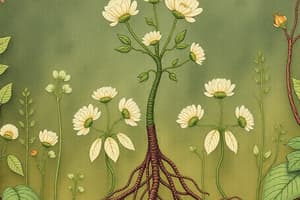Podcast
Questions and Answers
Vegetative growth allows plants to increase in ______ and biomass
Vegetative growth allows plants to increase in ______ and biomass
size
Primary growth occurs at the ______ of stems and roots, increasing plant height and depth
Primary growth occurs at the ______ of stems and roots, increasing plant height and depth
tips
______ growth occurs in woody plants, increasing stem and root diameter
______ growth occurs in woody plants, increasing stem and root diameter
Secondary
Hormones regulate ______ division and differentiation, promoting growth and development
Hormones regulate ______ division and differentiation, promoting growth and development
Auxins promote ______ elongation and differentiation
Auxins promote ______ elongation and differentiation
Light affects ______, promoting stem elongation towards light sources
Light affects ______, promoting stem elongation towards light sources
The process by which plants produce flowers, which contains the ______ organs
The process by which plants produce flowers, which contains the ______ organs
The transfer of ______ from the anther to the stigma is known as pollination
The transfer of ______ from the anther to the stigma is known as pollination
Fruits are formed from the ______ wall and contain seeds
Fruits are formed from the ______ wall and contain seeds
_______ propagation is the process by which plants produce new individuals from vegetative parts
_______ propagation is the process by which plants produce new individuals from vegetative parts
Asexual reproduction is the production of new individuals from vegetative parts without the involvement of ______
Asexual reproduction is the production of new individuals from vegetative parts without the involvement of ______
_______ growth occurs in woody plants, increasing stem and root diameter, but this type of growth is different from the one mentioned
_______ growth occurs in woody plants, increasing stem and root diameter, but this type of growth is different from the one mentioned
Flashcards are hidden until you start studying
Study Notes
Plant Growth and Reproduction
Vegetative Growth
- Allows plants to increase in size and biomass
- Occurs through the production of new cells in meristematic regions (apical and lateral)
- Types of vegetative growth:
- Primary growth: occurs at the tips of stems and roots, increases plant height and depth
- Secondary growth: occurs in woody plants, increases stem and root diameter
Cell Division and Differentiation
- Cell division: occurs in meristematic regions, resulting in new cells
- Cell differentiation: new cells mature and specialize into different cell types (e.g., xylem, phloem, epidermis)
- Hormones regulate cell division and differentiation, promoting growth and development
Hormonal Regulation
- Plant hormones (e.g., auxins, gibberellins, cytokinins, ethylene) regulate growth and development
- Auxins (e.g., IAA) promote cell elongation and differentiation
- Gibberellins promote stem elongation and seed germination
- Cytokinins promote cell division and differentiation
- Ethylene promotes fruit ripening and senescence
Environmental Factors
- Light: affects phototropism, promoting stem elongation towards light sources
- Temperature: affects growth rate, with optimal temperatures varying among plant species
- Water: essential for growth, with drought limiting growth and reproduction
- Nutrients: essential macronutrients (e.g., N, P, K) and micronutrients (e.g., Fe, Zn) support growth and development
Plant Growth and Reproduction
Vegetative Growth
- Plants increase in size and biomass through vegetative growth
- New cells are produced in meristematic regions, which include apical and lateral regions
- Two types of vegetative growth:
- Primary growth: occurs at stem and root tips, increasing plant height and depth
- Secondary growth: occurs in woody plants, increasing stem and root diameter
Cell Division and Differentiation
- Cell division occurs in meristematic regions, resulting in new cells
- New cells mature and specialize into different cell types, such as xylem, phloem, and epidermis
- Hormones regulate cell division and differentiation to promote growth and development
Hormonal Regulation
- Plant hormones regulate growth and development, including:
- Auxins (e.g., IAA): promote cell elongation and differentiation
- Gibberellins: promote stem elongation and seed germination
- Cytokinins: promote cell division and differentiation
- Ethylene: promotes fruit ripening and senescence
Environmental Factors
- Light affects plant growth, promoting:
- Phototropism: stem elongation towards light sources
- Temperature affects growth rate, with optimal temperatures varying among plant species
- Water is essential for growth, with drought limiting growth and reproduction
- Nutrients are essential for growth and development, including:
- Macronutrients: N, P, K
- Micronutrients: Fe, Zn
Plant Reproduction
Flowering
- Flowers contain reproductive organs and are composed of four main parts: sepals, petals, stamens, and carpels.
- Sepals protect the flower bud, while petals attract pollinators.
- Stamens produce pollen, which contains male reproductive cells.
- Carpels contain ovules, which contain female reproductive cells.
Pollination
- Pollination is the transfer of pollen from the anther to the stigma, allowing fertilization to occur.
- There are two main types of pollination: self-pollination (within the same flower or plant) and cross-pollination (between different flowers or plants).
- Pollinators include insects (bees, butterflies, moths), animals (birds, bats), and wind.
Fruit Formation
- Fruit formation occurs when the ovary of a flower develops into a fruit, which contains seeds.
- Fruits are formed from the ovary wall and can be classified as simple fruits (e.g., bananas), aggregate fruits (e.g., raspberries), or composite fruits (e.g., pineapples).
Vegetative Propagation
- Vegetative propagation is the process by which plants produce new individuals from vegetative parts (leaves, stems, roots).
- Methods of vegetative propagation include leaf cuttings, stem cuttings, root division, and layering.
Growth and Asexual Reproduction
- Growth refers to the increase in size and complexity of a plant.
- Asexual reproduction is the production of new individuals from vegetative parts without the involvement of gametes (sex cells).
- Types of asexual reproduction include the formation of rhizomes (e.g., ginger, potatoes), tubers (e.g., potatoes), bulbs (e.g., onions, garlic), and runners (e.g., strawberries).
Studying That Suits You
Use AI to generate personalized quizzes and flashcards to suit your learning preferences.




